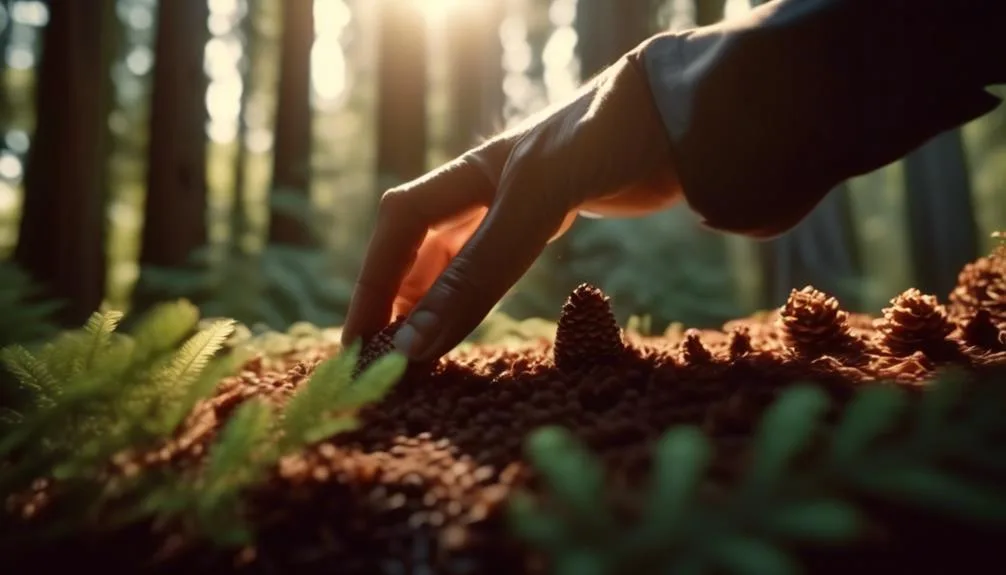Harvesting redwood tree seeds successfully requires the right timing, selection, technique, and preparation. It's a detailed process that demands a good understanding of the tree's life cycle. Surprisingly, the best time to gather these seeds may not be obvious.
Patience and precision are key.
In the upcoming paragraphs, we'll outline the crucial steps for harvesting redwood tree seeds and ensuring they germinate successfully.
Identifying the Right Time for Harvesting
To identify the right time for harvesting redwood tree seeds, observe the cones closely for signs of maturity and readiness. Look for cones that have turned brown and started to open, indicating that the seeds are ripe and ready for collection.
To ensure seed viability, conduct a simple test by gently squeezing the cones. If they release seeds easily, they're mature and can be harvested.
Environmental factors also play a crucial role in determining the optimal time for seed collection. Pay attention to weather conditions, as dry and warm weather can facilitate the release of seeds from the cones.
It's important to act promptly once the cones are ready, as waiting too long can result in seed loss due to dispersal by wind or animals.
Selecting Mature and Healthy Redwood Cones
Selecting mature and healthy redwood cones requires careful observation and attention to detail. When identifying signs of maturity, look for cones that are fully developed, with a deep brown color and tightly closed scales. Inspect the cones for any signs of damage, mold, or insect infestation, as these can affect the quality of the seeds.
As part of the seed collection process, choose cones that feel heavy and are still firmly attached to the tree, indicating that the seeds inside are fully formed. Avoid cones that are lightweight or have started to open, as they may have already dispersed their seeds.
Proper Techniques for Extracting Seeds From Cones
After identifying mature and healthy redwood cones, the next step is to carefully extract the seeds using proper techniques to ensure their viability for propagation. Here are three essential techniques for extracting seeds from redwood cones:
- Cone Opening Process: Gently heat the cones in a well-ventilated area to facilitate the natural opening of the scales and release the seeds.
- Extracting Techniques: Use tweezers or your fingers to delicately remove the seeds from the open cones, ensuring minimal damage to the seeds.
- Seed Storage and Planting Depth: Store the extracted seeds in a cool, dry place to maintain their viability, and when planting, ensure they're sown at a depth equivalent to two times their diameter.
Preparing Seeds for Storage and Planting
When preparing redwood tree seeds for storage and planting, it's essential to ensure that they're free from any debris and fully dried to maintain their viability and promote successful germination.
After harvesting, gently remove any remaining debris from the seeds using a fine mesh sieve. Once clean, spread the seeds out in a single layer on a screen or paper towel in a dry, well-ventilated area. Allow the seeds to air dry for at least one to two weeks, ensuring they aren't exposed to direct sunlight.
To store the seeds, place them in a breathable container, such as a paper envelope or a cloth bag, and store them in a cool, dry place until planting.
When ready to plant, carefully follow recommended methods for sowing redwood tree seeds to maximize their chance of successful germination and growth.
Ensuring Successful Germination of Redwood Tree Seeds
To ensure successful germination of redwood tree seeds, carefully prepare a suitable planting site with well-draining soil and partial shade. When caring for the seeds, keep these key points in mind:
- Soil Preparation: Ensure the planting site has well-draining soil to prevent waterlogging, which can lead to seed rot. Amend the soil with organic matter to improve its texture and fertility.
- Watering: Provide consistent moisture to the seeds by watering them regularly. Avoid overwatering, as this can be detrimental to the germination process.
- Seedling Care and Transplanting: Once the seeds have germinated and grown into seedlings, provide proper care by protecting them from extreme weather conditions and pests. When the seedlings are strong enough, carefully transplant them to their permanent location.
Following these steps will greatly increase the chances of successful germination and healthy growth of redwood tree seeds.
Conclusion
Armed with the knowledge of harvesting redwood tree seeds, you're set to gather and nurture these natural wonders. Seek out mature cones, employ proper extraction methods, and store the seeds diligently to ensure successful growth.
Embrace the journey of cultivating your own magnificent redwood trees. Happy planting, and may your efforts blossom into a thriving forest of beauty and resilience.

My interest in trees started when I first saw the giant sequoias in Yosemite.
I was a teenager then, and I remember thinking, “I need to learn more about this.”
That moment stuck with me.
A few years later, I went on to study forestry at Michigan Tech.
Since graduating, I’ve worked in a mix of hands-on tree care and community education.
I’ve spent over ten years helping people understand how to plant, maintain, and protect the trees in their neighborhoods.
I don’t see trees as just part of the landscape.
They are living things that make a real difference in our daily lives.
